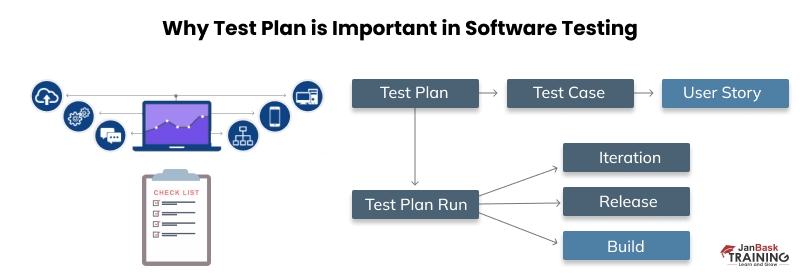Grab Deal : Flat 30% off on live classes + 2 free self-paced courses - SCHEDULE CALL
In the world of software testing, a well-defined test plan is essential for guaranteeing the success of any project. A test plan acts as a roadmap that outlines the approach, objectives, scope, and resources required for testing activities. In this comprehensive blog, we will delve into the intricacies of test plans in software testing. We'll explore their objectives, types available, and best practices to create an effective test plan. We will also guide you through how to write a test plan in software testing. If the subject piques your interest by the end of this blog, you can opt to become a QA tester Software Tester.
A software test plan is a record that delivers precise data about how testing activities will be accomplished throughout the software development lifecycle (SDLC). It acts as a blueprint for testers to ensure that all aspects of an application are thoroughly tested. A good test plan includes the introduction, objectives, scope, deliverables, schedule, risk assessment/mitigation strategies, and resource allocation/requirements.
Objectives of The Software Test Plan
1. Introduction:
The introduction section sets the context by providing an overview of the project or application under consideration. It also highlights critical stakeholders involved in testing activities.
2. Objectives:
This section defines specific goals and objectives that testing efforts need to achieve. These objectives can include functional validation, performance evaluation, or security assessment based on project requirements.
3. Scope:
The scope section outlines what functionalities or features will be covered during testing and any exclusions, if applicable. It helps define boundaries within which tests should focus their efforts.
4. Deliverables:
Deliverables refer to tangible outputs produced during testing phases like test cases/scripts, documentation/reports generated after each round/test cycle completion, etc. This section specifies what documents/artifacts must be produced at each stage.
5. Schedule:
The schedule section provides timelines for different stages/phases of testing, including start/end dates for planning/designing/executing/reviewing cycles. It helps in managing testing efforts effectively and ensures timely delivery.
6. Risks Assessment/Mitigation Strategies:
This section identifies potential risks that may impact the success of testing activities and proposes strategies to mitigate them. Risk identification, analysis, prioritization, and mitigation planning are crucial for successful test execution.
7. Resource Allocation/Requirements:
The resource allocation/requirements section outlines the resources needed for testing, such as hardware, software, tools/licenses required, and roles/responsibilities assigned to team members involved in testing.
A test plan is a crucial document in the field of Quality Assurance (QA) as it outlines the approach, scope, objectives, and resources required for testing activities. It serves as a roadmap that guides QA teams throughout the testing process and ensures that all necessary aspects are covered.One of the primary reasons why a test plan is essential in QA is its ability to provide clarity and direction. Clearly defining the goals and objectives of testing helps QA teams understand what needs to be accomplished during each testing phase. Without a well-defined test plan, there may be confusion among team members regarding their roles and responsibilities, leading to inefficiencies and delays.Moreover, a test plan also plays an essential role in managing expectations. It allows stakeholders to have visibility into how much time will be required for testing activities and when they can expect results. This transparency helps manage project timelines effectively by ensuring sufficient time for thorough testing before product release.Another significant aspect of a test plan is risk management. Through careful analysis and identification of potential risks associated with software development or changes made during implementation, QA teams can prioritize their efforts accordingly. This prioritization enables them to focus on critical areas where failures could significantly lead to severe consequences or impact user experience.
Furthermore, having a comprehensive test plan improves communication within the team and with other stakeholders involved in the project. It provides clear guidelines on what needs to be tested, including specific functionalities or scenarios that should be covered during each type of testing (such as functional or performance tests). As a result, everyone involved has a shared understanding of what needs to be achieved through testing.To illustrate further with an example, Suppose there's an e-commerce website undergoing major updates involving changes in payment processing functionality. A well-crafted test plan would outline specific scenarios such as successful payments using different payment methods (credit cards or PayPal), handling declined transactions gracefully while displaying appropriate error messages without compromising sensitive customer data, and testing the integration with third-party payment gateways to ensure smooth transactions. This level of detail ensures that all critical aspects are covered during testing. A test plan is an indispensable tool in QA that provides structure, clarity, and direction for teams involved in software testing. It helps manage expectations, mitigate risks effectively, improve communication between the team and stakeholders, and ensure comprehensive coverage of all necessary aspects during testing activities. By investing time and effort into creating a well-thought-out test plan, QA teams can significantly enhance the quality of their software products while reducing potential issues or errors before they reach end-users.

Different Types of Test Plans
There are various types of test plans depending on factors such as project size/type/complexity:
1. Functional Test Plan:
This type focuses on verifying if all functional requirements specified by stakeholders are met through rigorous functional tests like unit tests, integration tests, etc.
2. Performance Test Plan:
This type of test plan covers performance-related aspects like load testing, stress testing, and scalability. It ensures the system can handle expected user loads without any performance degradation.
3. Security Test Plan:
This type of test plan addresses security vulnerabilities and risks. It includes penetration testing, vulnerability scanning, and other security measures to ensure data integrity and confidentiality.
4. User Acceptance Test Plan:
This type focuses on validating if the software meets end-users expectations by conducting tests that simulate real-world scenarios. User acceptance tests help identify usability issues before release.
5. Compatibility Test Plan:
Compatibility test plans ensure the software can function correctly across different platforms, operating systems, and devices. It involves testing the software on various configurations to identify any compatibility issues. For example, a compatibility test plan for a web application may involve testing it on different browsers, such as Chrome, Firefox, and Safari, to ensure it works consistently across all of them. It may also involve testing the application on different operating systems like Windows and macOS to verify its compatibility.
6. Regression Test Plan:
Regression testing is performed when changes or updates are made to an existing software system. The regression test plan ensures that these modifications do not introduce new bugs or cause unintended consequences in previously working functionality.The plan typically includes retesting all affected areas within the system to verify that they still work correctly after making changes. This test plan helps ensure that fixes or updates do not negatively impact other system parts.
7. Localization Test Plan:
Localization refers to adapting a software product for use in specific regions or locales by translating text strings, adjusting date/time formats, currencies, etc., according to local conventions and requirements.A localization test plan focuses on verifying if the localized version functions correctly regarding language translations, cultural adaptability (e.g., displaying dates in the correct format), and compliance with local regulations (such as labeling requirements). For instance, if a company wants to release its product in multiple countries with different languages and cultures, it would create a localization test plan specific to each region where it intends to launch its product.
8. Installation/Deployment Test Plan:
This test plan ensures smooth installation and deployment processes for software applications or systems. It verifies whether installation packages are created correctly and whether deployments occur without errors or conflicts with existing infrastructure components.The goal is to ensure users can easily install and deploy the software without encountering technical difficulties or complications during setup procedures.For example, a mobile application installation/deployment test plan may involve testing the installation process on different devices and operating systems to ensure it works smoothly without any issues or errors. It may also include verifying that the software can seamlessly be deployed on various servers or cloud platforms.
Benefits of a Well-Defined Test Plan
A well-defined test plan offers several benefits throughout the software development lifecycle. It also helps you become an expert in the automation testing domain:
1. Improved Test Coverage:
By clearly defining the scope and objectives of testing, a test plan ensures comprehensive coverage of all functionalities/features within an application.
2. Efficient Resource Management:
A detailed resource allocation section helps optimize resource utilization by identifying specific requirements and assigning responsibilities accordingly.
3. Effective Risk Management:
Identifying potential risks early on allows testers to develop appropriate mitigation strategies, ultimately reducing project delays or failures caused by unforeseen issues during testing.
4. Enhanced Communication & Collaboration:
A well-documented test plan serves as a communication tool between stakeholders involved in software development/testing processes, ensuring everyone is aligned with project goals/objectives, thereby promoting team collaboration.
5. Improved Test Efficiency:
A well-defined test plan helps testers prioritize their testing efforts by outlining the critical areas that need to be tested first. This ensures that limited resources are utilized effectively and efficiently, leading to faster and more accurate test execution.
6. Clear Test Objectives:
A test plan provides clear goals and objectives for each testing phase, allowing testers to focus on specific outcomes. This helps identify any gaps or deficiencies in the software early on, enabling timely bug fixes and improvements.
7. Reduced Costs:
Organizations can avoid costly rework caused by missed defects or incomplete testing with a well-defined test plan. By thoroughly planning and executing tests, potential issues can be identified at an early stage when they are easier and cheaper to fix.
8. Increased Customer Satisfaction:
By ensuring comprehensive coverage of all functionalities/features within an application, a well-defined test plan minimizes the risk of releasing a faulty product. This increases customer satisfaction as customers receive high-quality software that meets their expectations.
9. Regulatory Compliance:
In industries where compliance with regulations is mandatory (such as healthcare or finance), having a well-documented test plan is crucial for demonstrating adherence to industry standards. It provides evidence of thorough testing processes followed during development and ensures compliance with regulatory requirements.
10. Continuous Improvement:
A well-defined test plan is a reference document for future projects, allowing teams to learn from past experiences and improve their testing processes over time. Lessons learned from previous projects can be incorporated into new plans, improving quality assurance practices continuously. For example, let's assume a scenario where a company designs an e-commerce website. A well-defined software test plan would outline all the functionalities/features that need to be tested, such as user registration/login, product browsing/searching/filtering functionality, shopping cart management/payment processing functionality, order tracking/management functionality, etc.
The resource allocation section would specify which team members are responsible for conducting different tests like functional testing, usability testing, performance testing, etc. This helps in efficiently utilizing the skills and expertise of each team member.The risk management section would identify potential risks such as security vulnerabilities, compatibility issues with different browsers/devices, scalability concerns, etc. Testers can then develop appropriate mitigation strategies like implementing security measures, cross-browser/device testing, and load/stress testing to ensure the website performs optimally, even under heavy user loads.
By having a well-documented test plan, all stakeholders, including developers, testers, project managers, and clients, agree regarding project goals/objectives. This promotes effective communication and collaboration among teams throughout the software development lifecycle.A well-defined software test plan is essential for ensuring comprehensive test coverage, efficient resource management, effective risk management, and improved communication/collaboration within software development projects. It increases efficiency in testing efforts while reducing costs and improving customer satisfaction. Additionally, it ensures regulatory compliance in industries where it is mandatory while also facilitating continuous improvement in quality assurance practices over time. All this knowledge will be helpful when preparing for QA testing interviews.

Below are the eight steps that can be followed to write a test plan:
1. Analyze The Product: This phase focuses on analyzing the product, Interviewing clients, designers, and developers, and performing a product walkthrough. This stage answers the following questions:
2. Design The Test Strategy: The test strategy document is prepared by the manager and details the following information:
3. Define Test Objectives: This phase defines the objectives and expected results of the test execution. Objectives include:
4. Define Test Criteria: Two main testing criteria govern all the activities in the testing project:
Suspension Criteria: Suspension criteria define the benchmarks for suspending all the tests.
Exit Criteria: Exit criteria define the benchmarks that signify the successful completion of the test phase or project. These are expected results and must match before moving to the next stage of development.
5. Resource planning: This phase aims to create a detailed list of all required resources for project completion. For example, human effort, hardware and software requirements, all infrastructure needed, etc.
6. Plan Test Environment: This phase is critical as the test environment is where the QAs run their tests. The test environments must be real devices installed with real browsers and operating systems so that testers can monitor software behavior in real user conditions.
7. Schedule and Estimation: Break down the project into smaller tasks and allocate time and effort for each task. This helps in efficient time estimation. Create a schedule to complete these tasks in the designated time with a specific amount of effort.
8. Determine Test Deliverables: Test deliverables refer to the list of documents, software testing tools, and other equipment that must be created, provided, and maintained to support testing activities in the project.
A robust test plan is vital in achieving high-quality software products by providing clear guidelines for effective planning, execution, monitoring, and control of various testing activities throughout SDLC phases. By understanding its essential components and benefits outlined above, organizations can ensure their software undergoes rigorous quality assurance, resulting in improved customer satisfaction and reduced post-release defects. Can also learn about test plan in manual testing and how to perform test plan in testing. Enroll in online courses for manual testing and master the software testing concepts like test case development, different types of testing, software testing methodologies, test case design techniques, different levels of testing, testing environment, and testing tools, etc.
QA Training For Administrators & Developers


Testing with V Models: A Guide to Their Application


Understanding The Software Development Life Cycle (SDLC) in QA

Cyber Security

QA

Salesforce

Business Analyst

MS SQL Server

Data Science

DevOps

Hadoop

Python

Artificial Intelligence

Machine Learning

Tableau
Download Syllabus
Get Complete Course Syllabus
Enroll For Demo Class
It will take less than a minute
Tutorials
Interviews
You must be logged in to post a comment